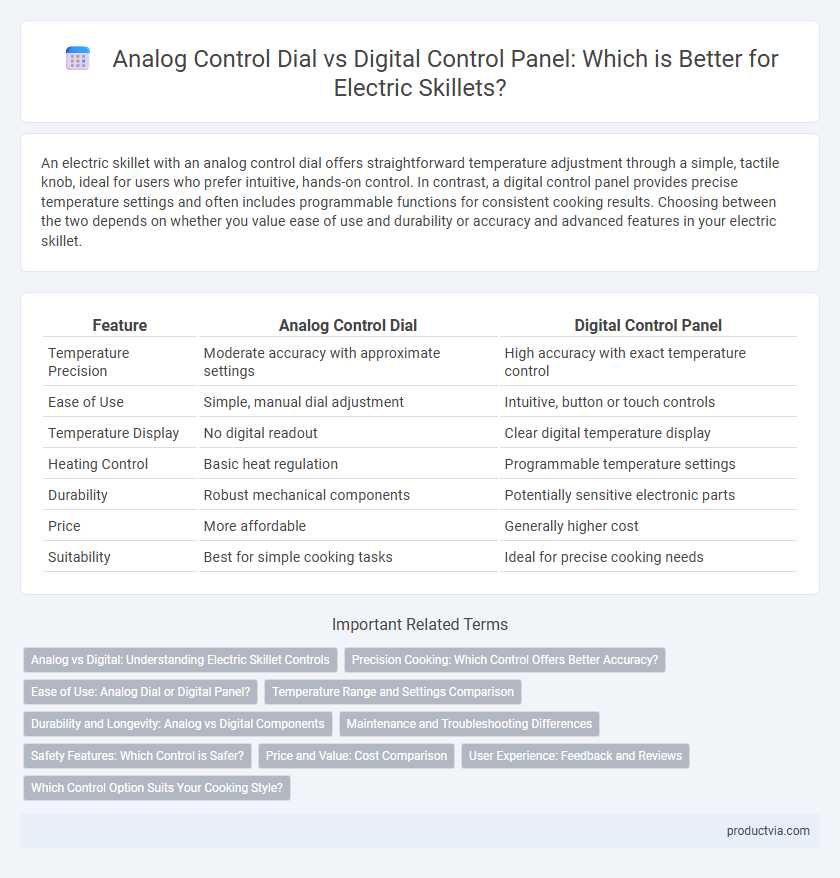An electric skillet with an analog control dial offers straightforward temperature adjustment through a simple, tactile knob, ideal for users who prefer intuitive, hands-on control. In contrast, a digital control panel provides precise temperature settings and often includes programmable functions for consistent cooking results. Choosing between the two depends on whether you value ease of use and durability or accuracy and advanced features in your electric skillet.
Table of Comparison
| Feature | Analog Control Dial | Digital Control Panel |
|---|---|---|
| Temperature Precision | Moderate accuracy with approximate settings | High accuracy with exact temperature control |
| Ease of Use | Simple, manual dial adjustment | Intuitive, button or touch controls |
| Temperature Display | No digital readout | Clear digital temperature display |
| Heating Control | Basic heat regulation | Programmable temperature settings |
| Durability | Robust mechanical components | Potentially sensitive electronic parts |
| Price | More affordable | Generally higher cost |
| Suitability | Best for simple cooking tasks | Ideal for precise cooking needs |
Analog vs Digital: Understanding Electric Skillet Controls
Analog control dials on electric skillets offer tactile feedback and intuitive temperature adjustments, ideal for cooks who prefer manual precision. Digital control panels provide exact temperature settings with programmable timers, enhancing cooking accuracy and convenience. Choosing between analog and digital controls depends on whether you prioritize simplicity and immediacy or advanced features and precise temperature management.
Precision Cooking: Which Control Offers Better Accuracy?
Analog control dials on electric skillets provide basic temperature adjustments with limited precision, often resulting in temperature fluctuations that can affect cooking consistency. Digital control panels offer superior accuracy by allowing exact temperature settings, often in one-degree increments, ensuring more consistent and predictable cooking results. Precision cooking is significantly enhanced with digital controls due to their ability to maintain stable temperatures and provide real-time feedback.
Ease of Use: Analog Dial or Digital Panel?
Analog control dials on electric skillets offer intuitive, tactile feedback that allows users to quickly adjust cooking temperatures without referring to a manual. Digital control panels provide precise temperature settings and often include timers, enhancing accuracy but requiring a learning curve for first-time users. For ease of use, analog dials are preferred by those who prioritize straightforward, hands-on control, while digital panels suit users seeking exact temperature management with programmable options.
Temperature Range and Settings Comparison
Analog control dials on electric skillets typically offer a temperature range from 200degF to 450degF with basic marked increments, providing straightforward manual adjustments. Digital control panels provide precise temperature settings often adjustable in 5degF increments, ranging between 150degF and 475degF, allowing for more exact cooking control. Digital panels frequently include customizable presets and timer functions, enhancing versatility beyond the simpler analog dial settings.
Durability and Longevity: Analog vs Digital Components
Analog control dials for electric skillets feature mechanical components that are generally more durable and resistant to wear over time, offering consistent performance through frequent use. Digital control panels rely on electronic circuits and sensors, which can be more prone to malfunction due to exposure to heat, moisture, and electrical surges, potentially reducing overall lifespan. Choosing an electric skillet with an analog dial often ensures greater longevity and fewer maintenance issues compared to digital counterparts.
Maintenance and Troubleshooting Differences
Analog control dials on electric skillets typically allow for straightforward maintenance due to their simple mechanical components, making troubleshooting easier without specialized tools. Digital control panels involve more complex electronics that may require professional service or replacement of circuit boards when malfunctions occur. Users can often resolve issues with analog dials by cleaning or replacing knobs, while digital panels may need software resets or sensor diagnostics for effective troubleshooting.
Safety Features: Which Control is Safer?
Analog control dials for electric skillets provide simple, tactile adjustments that reduce distractions and the risk of accidental settings changes, enhancing safety during cooking. Digital control panels often include built-in safety features such as automatic shut-off, precise temperature controls, and lock functions that prevent unintended operation. While analog dials offer reliability through straightforward use, digital panels typically provide advanced safety mechanisms that minimize the risk of overheating and accidents.
Price and Value: Cost Comparison
Analog control dials on electric skillets typically offer a lower upfront cost, making them budget-friendly for basic cooking needs. Digital control panels, while generally more expensive, provide precise temperature adjustments and enhanced cooking features that can justify the higher price for users seeking greater value and versatility. Evaluating the balance between initial investment and long-term cooking performance helps determine the best option based on cost and functionality.
User Experience: Feedback and Reviews
Analog control dials on electric skillets offer tactile feedback and straightforward temperature adjustments, favored by users who prefer simplicity and quick responsiveness. Digital control panels provide precise temperature settings and programmable features, appealing to users seeking accuracy and modern convenience despite occasional complexity in navigation. Reviews highlight that analog dials excel in ease of use, while digital panels enhance cooking consistency through exact temperature control.
Which Control Option Suits Your Cooking Style?
Analog control dials on electric skillets offer intuitive, tactile adjustments for those who prefer a straightforward, hands-on cooking experience. Digital control panels provide precise temperature settings and programmable options, ideal for recipes requiring exact heat levels and consistency. Choose analog for simplicity and quick tweaking, or digital for accuracy and advanced cooking versatility.
Analog control dial vs Digital control panel for electric skillet Infographic

 productvia.com
productvia.com